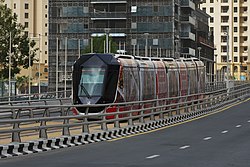|
Dubai Tram
The Dubai Tram (Arabic: ترام دبي) is a tramway located in Al Sufouh, Dubai, United Arab Emirates. It runs for 14.5 kilometers (9.0 mi) along Al Sufouh Road from Dubai Marina to the Palm Jumeirah and Al Sufouh. The tram connects with the DMCC and Sobha Realty stations of the Dubai Metro's Red Line, and two more stations are expected to connect with the tram in the future. The Dubai Tram is also connected with the monorail of the Palm Jumeirah at the entrance of the Palm from Sufouh Road.[1]  The first section, a 10.6-kilometer (6.6 mi) long tram line which serves 11 stations, was ceremonially inaugurated on 11 November 2014, by Sheikh Mohammed bin Rashid Al Maktoum, Vice-President and Prime Minister of UAE and Ruler of Dubai, with the line officially opening for public service at 6:30 am (UTC 04:30) on 12 November 2014.[2] The Dubai Tram is the fourth tramway project in the world after the Bordeaux tramway in 2003, and the Reims and Angers tramways in 2011, to be powered by the Alstom APS ground-based electric supply system.[3] ConstructionThe planning and construction of the Dubai Tram was undertaken by a consortium of Alstom, Besix and Parsons.[4][5][6][7] Construction has been divided into two phases: Phase 1, was expected to be open in April 2011, however it was delayed until November 2014. Upon completion, Phase 1 of the tramline will operate 11 trams, serving 11 stations, covering 10.6 kilometers (6.6 mi) of route. The Phase 1 will cost AED 3.18 Billion.[1] Some 9.5 kilometers (5.9 mi) of the Dubai Tram project will be built as part of the first Phase 1.[1] Phase 2 will add 14 more trams and eight more stations along an additional 4 kilometers (2.5 mi) of route. As of 10 October 2010, the construction work on Dubai Tramway had progressed according to the scheduled completion of 2014.[8] However the project was put on hold a month later due to lack of finances. The construction of the tramway was resumed in January 2011 with 30% of Phase 1 having been completed.[9] In mid-2014, the tramline entered the testing phase, and it began operation in November 2014.[10][11][12] Route
Operations The Dubai Tram is operated by Keolis.MHI under contract to the Dubai Roads & Transport Authority.[13][14][15] There are over 80 certified drivers for the tram. To ensure the safety of the tram and the passengers, every driver is required to take (and pass) an alcohol test before driving the tram. The trams also have a dead man's switch, which the drivers are required to press every three to five seconds, failing which the tram will come to a halt.[16] Hours of operation and frequencyThe Dubai Tram operates from 06:00 a.m. until 01:00 a.m. except on Sundays when it operates from 09:00 a.m. until 01:00 a.m..[17] FaresThe tram has a fixed fare of AED 3 per trip regardless of the distance travelled, making it one of the cheapest fares for trams, compared to other cities. The fare for passengers using the Red Nol Ticket will be AED 4 (US$1.09) per ride.[18] A Nol Card can be used by passengers to check-in and check-out of the tram by scanning the card at the platform screen doors.
Rolling stockThe Dubai Tram use 11 Alstom Citadis 402 trams for Phase 1.[21] The trams are 44 m (144 ft) long with a capacity of 408 passengers.[22] Maximum speed is 50 km/h (31 mph), giving an average operational speed of 20 km/h (12 mph). The trams use the Alimentation par le Sol II (APS II) ground-level power supply,[22] and so do not need overhead cables.[4] This method was first used in Bordeaux, France. The Dubai Tram is the world's first tram network to use platform screen doors at the stations, as well as a new Supervised Vehicle Operation (SVO) mode that will ensure accurate station stop and safety during passenger transfer.[4][5][6][7] The trams have Gold (first) and silver classes, and space dedicated to women and children.[1][22] The first tram was presented to Mattar Al Tayer, Chairman of the Road & Transport Authority, at Alstom's La Rochelle factory on 14 June 2013.[22] Incidents and accidents
Linking with other networksThe Dubai Tram has 2 stations that are interconnected to 2 Dubai Metro stations:
It is also interconnected to the Palm Monorail:
See alsoReferences
External links
|
||||||||||||||||||||||||||||||||||||||||||||||||||||||||||||||||||||||||||||||||||||||||||||||||||||||||||||||||||||||



